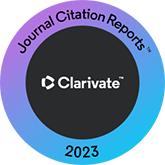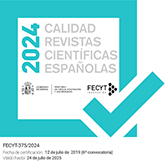Towards the applicability of voice quality in forensic phonetics
DOI:
https://doi.org/10.3989/loquens.2022.e093Keywords:
Voice disguise, laryngeal voice quality, forensic phonetics, applicabilityAbstract
Voice quality derived from long-term laryngeal settings stands out as a potentially individualizing trait of speakers. This places it in an advantageous situation with respect to other phonetic parameters used in forensic linguistics. However, anyone confronted with its analysis will immediately run into a methodological difficulty stemming from its inherently multidimensional nature. In this lies its main disadvantage and the fundamental reason why its analysis is not always considered in the traditional approach used in the comparison of speakers for identification purposes. Based on an experimental inquiry on voice disguised by means of falsetto, this study shows that it is possible to work with a reduced set of laryngeal features responsible for voice quality and facilitate its interpretation and explanation, which is a critical issue for forensic practice.
Downloads
References
Alves, H., Fernández Trinidad, M., Gil Fernández, J., Infante, P., Lahoz-Bengoechea, J. M., Pérez Sanz, C. y San Segundo, E. (2012). Disguised voices: A perceptual experiment. 3rd European Conference of the International Association of Forensic Linguistic
Alves, H., Gil Fernández, J., Pérez Sanz, C. y San Segundo, E. (2014). La cualidad individual de la voz y la identificación del locutor: el proyecto CIVIL. En Y. Congosto, M. L. Montero Curiel, y A. Salvador Plans (Eds.), Fonética experimental, educación superior e investigación (Vol. 1, pp. 591-612). Madrid: Arco/Libros.
Baayen, R. (2008). Analyzing Linguistic Data: A Practical Introduction to Statistics. Cambridge: Cambridge University Press. https://doi.org/10.1017/CBO9780511801686
BioMetroSoft®. (2022). Informe técnico para documentar la funcionalidad de la aplicación informática BioMet®Fore [versión 1.0].
BioMetroSoft®. (2014). BioMet®Phon: Tool for de Evaluation of Voice Quality and Biometri. User's Manual [versión 2.3].
Drygajlo, A., Jessen, M., Gfroerer, S., Wagner, I., Vermeulen, J. y Niemi, T. (2015). Methodological Guidelines for Best Practice in Forensic Semiautomatic and Automatic Speaker Recognition. Frankfurt: Verlag für Polizeiwissenschaft. https://enfsi.eu/wp-content/uploads/2016/09/guidelines_fasr_and_fsasr_0.pdf
ENFSI, European Network of Forensic Science Institutes (2015). ENFSI Guideline or Evaluative Reporting in Forensic Science, http://enfsi.eu/wp-content/uploads/2016/09/m1_guideline.pdf
Fernández Trinidad, M. (2018). Caracterización del falsetto y sus consecuencias para la discriminación de voces. [Tesis doctoral inédita]. Universidad Nacional de Educación a Distancia.
Fernández Trinidad, M. y Rojo, J. (2019). Perceptual cues for individual voice quality. En J. Gil Fernández y M. Gibson (Eds.), Romance Phonetics and Phonology (pp. 161-176). Oxford University Press. https://doi.org/10.1093/oso/9780198739401.003.0010
Figueiredo, R. y de Souza Britto, H. (1996). A report on the acoustic effects of one type of disguise. Forensic Linguistics, 3, 168-175. https://doi.org/10.1558/ijsll.v3i1.168
Gil, J. Alves, H. y Hierro, J. A. (2012). Proposition raisonnée de protocole de capture de voix connue à des fins judiciaires. Revue Internationale de Criminalistique et de Police Scientifique et Technique, LXV, 319-345.
Gil Fernández, J., Fernández Trinidad, M., Infante, P. y Lahoz-Bengoechea, J. M. (2017). "Obtaining speech samples for research and expertise in forensic phonetics". En: Orletti, F. y Mariottini, L. (Eds.) Theories, Practices, Instruments of Forensic Linguistics (pp. 27-50). Cambridge Scholars Publishing.
Gil Fernández, J. y San Segundo, E. (2014). La cualidad de voz en fonética judicial. En E. Garayzábal, M. Jiménez y M. Reigosa (Coords.), Lingüística Forense. La Lingüística en el ámbito legal y policial (pp. 154 -199). Madrid: Euphonía Ediciones.
Gobl, C. y Ní Chasaide, A. (2010). Voice source variation and its communicative functions. En W. Hardcastle, J. Laver, y F. Gibbon (Eds.), The Handbook of Phonetic Sciences (2.a ed., pp. 378-423). Oxford: Wiley-Blackwell. https://doi.org/10.1002/9781444317251.ch11
Godino, J., Gómez-Vilda, P. y Blanco, M. (2006). Dimensionality reduction of a pathological voice quality assessment system based on Gaussian mixture models and short-term cepstral parameters. IEEE Transactions on Biomedical Engineering, 53(10), 1943-1953. https://doi.org/10.1109/TBME.2006.871883 PMid:17019858
Gold, E. y French, P. (2011). International practices in forensic speaker comparison. International Journal of Speech, Language, and the Law, 18(2), 293-307. https://doi.org/10.1558/ijsll.v18i2.293
Gómez-Vilda, P. (2022). Informe técnico para documentar la funcionalidad de la aplicación informática BioMet®Fore. Versión 1.0, 2022 NeuSpeLab, Glottex VAS (www.glottalsolutions.com)
Gómez-Vilda, P.; Rodellar Biarge, M. V.; Nieto Lluis, V.; Martínez Olalla, R.; Álvarez Marquina, A.; Scola Yurrita, B.; Ramírez Calvo, C.; Poletti Serafini, D. y Fernández Fernández, M. (2013). BioMet®Phon: A system to monitor phonation quality in the clinics. En eTELEMED 2013: The Fifth International Conference on eHealth, Telemedicine, and Social Medicine (pp. 253-258), Nice, France. ISBN 978-1-61208-252-3.
González-Rodríguez, J., Gil, J., Pérez, R. y Franco-Pedroso, J. (2014). What are we missing with i-vectors? A perceptual analysis of i-vector based falsely accepted trials. Proceedings of Odyssey 14. The Speaker and Language Recognition Workshop (pp. 33-40). https://doi.org/10.21437/Odyssey.2014-6
Gunning, D., Stefik, M., Choi, J., Miller, T., Stumpf, S. y Yang, G-Z. (2019). XAI- Explainable artificial intelligence. Science Robotics, 4(37), eaay7120. https://doi.org/10.1126/scirobotics.aay7120 PMid:33137719
IAFPA, International Association of Forensic Phonetics and Acoustics (2020). Code of Practice.http://www.iafpa.net/wp-content/uploads/2020/09/IAFPA-Code-of-Practice-2020.pdf
IAFLL, International Association of Forensic and Legal Linguistics (s/d). Code of Practice.https://www.iafl.org/wp-content/uploads/2018/07/IAFL_Code_of_Practice_1-1.pdf
Jessen, M. (1997). Speaker-specific information in voice quality parameters. The International Journal of Speech, Language, and the Law, 4(1), 84-103. https://doi.org/10.1558/ijsll.v4i1.84
Jolliffe, I. (1986). Principal component analysis and factor analysis. En Principal Component Analysis (pp. 115-128). New York: Springer. https://doi.org/10.1007/978-1-4757-1904-8_7
Künzel, H. (2000). Effects of voice disguise on speaking fundamental frequency. Forensic Linguistics, 7, 149-179. https://doi.org/10.1558/sll.2000.7.2.149
Künzel, H., González-Rodríguez, J. y Ortega-García, J. (2004). Effect of voice disguise on the performance of a forensic automatic speaker recognition system. En Proceedings of Odyssey 04. The Speaker and Language Recognition Workshop. (pp. 1-4).
Lahoz-Bengoechea, J. M., Villa Villa, J. y Gil Fernández, J. (2017). Fillers in disguised accented speech. 13th Biennial Conference of the International Association of Forensic Linguists.
Masthoff, H. (1996). A report on a voice disguise experiment. Forensic Linguistics, 3(1), 160-167. https://doi.org/10.1558/ijsll.v3i1.160
Nolan, F. (1983). The Phonetic Bases of Speaker Recognition. Cambridge University Press.
Núñez, F. (2013). Fisiología de la fonación. En I. Cobeta, F. Núñez y S. Fernández (Eds.), Patología de la voz (pp. 55-75). Barcelona: Marge Medica Books.
Palacios, D. (2018). Contribución al estudio de selección de parámetros para identificación de estrés en la voz. [Tesis doctoral inédita]. Universidad Politécnica de Madrid.
Palacios, D., Rodellar, V., Lázaro, C., Gómez, A. y Gómez, P. (2020). An ICA-based method for stress classification from voice samples. Neural Computing and Applications, 32(24), 17887-17897. https://doi.org/10.1007/s00521-019-04549-3
Perrot, P., Aversano, G. y Chollet, G. (2007). Voice disguise and automatic detection: review and perspectives. En Y. Stylianou, M. Faundez-Zanuy y A. Esposito (Eds.), Progress in Nonlinear Speech Processing (pp. 101-117). Berlin: Springer. https://doi.org/10.1007/978-3-540-71505-4_7
Perrot, P. y Chollet, G. (2008). The question of disguised voice. The Journal of the Acoustical Society of America, 123(5), 3878. https://doi.org/10.1121/1.2935782
Perrot, P., Preteux, C., Vasseur, S. y Chollet, G. (2007). Detection and recognition of voice disguise. Proceedings IAFPA 2007 (pp. 1-3). Plymouth, UK: The College of St Mark y St John.
Praveena, J. y Krishna, Y. (2015). Identifying speaker from disguised speech using aural perception and Mel-frequency cepstral coefficient. Journal of Indian Speech Language & Hearing Association, 29(2), 28-34. https://doi.org/10.4103/0974-2131.185974
Rodellar-Biarge, V., Palacios-Alonso, D., Nieto-Lluis, V. y Gómez-Vilda, P. (2015). Towards the search of detection in speech-relevant features for stress. Expert Systems, 32(6), 710-718. https://doi.org/10.1111/exsy.12109
Rodman, R. (1998). Speaker recognition of disguised voices: A program for research. Proceedings of the Consortium on Speech Technology in Conjunction with the Conference on Speaker Recognition by Man and Machine: Directions for Forensic Applications (pp. 1-22). Ankara, Turkey: COST250 Publishing Arm.
Rose, P. (2002). Forensic Speaker Identification. London: Taylor y Francis. https://doi.org/10.1201/9780203166369
San Segundo, E. y Gómez-Vilda, P. (2014). Evaluating the forensic importance of glottal source features through the voice analysis of twins and non-twin siblings. Language and Law/Linguagem e Direito, 1(2), 22-41.
Titze, I. R. (2000 [1994]). Principles of voice production (2nd edition). Iowa, City: National Center for Voice and Speech.
Wolf, J. (1972). Efficient acoustic parameters for speaker recognition. The Journal of the Acoustical Society of America, 51(6B), 2044-2056. https://doi.org/10.1121/1.1913065
Zhang, C. y Tan, T. (2008). Voice disguise and automatic speaker recognition. Forensic Science International, 175(2), 118-122. https://doi.org/10.1016/j.forsciint.2007.05.019 PMid:17646071
Published
How to Cite
Issue
Section
License
Copyright (c) 2023 Consejo Superior de Investigaciones Científicas (CSIC)

This work is licensed under a Creative Commons Attribution 4.0 International License.
© CSIC. Manuscripts published in both the print and online versions of this journal are the property of the Consejo Superior de Investigaciones Científicas, and quoting this source is a requirement for any partial or full reproduction.
All contents of this electronic edition, except where otherwise noted, are distributed under a Creative Commons Attribution 4.0 International (CC BY 4.0) licence. You may read the basic information and the legal text of the licence. The indication of the CC BY 4.0 licence must be expressly stated in this way when necessary.
Self-archiving in repositories, personal webpages or similar, of any version other than the final version of the work produced by the publisher, is not allowed.














